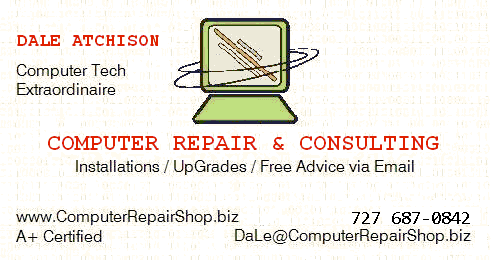And while ZoneAlarm is on my mind. . .
It has come to my attention that the latest version of ZoneAlarm doesn’t support Windows 98. The version you already have will continue to work like it always has, but you won’t be able to install any future updates unless and until you ‘upgrade’ to Windows XP. This surprises and saddens me, as Windows XP SP 2 has a pretty good firewall built into it — it’s the Win 98 users who need ZoneAlarm the most! Nevertheless, they didn’t ask my opinion, they just went ahead and did what they were gonna do.
(Let’s be realistic here, folks: if you have a PC old enough to be running Windows 98, your hardware, even if it will let you install and run Windows XP, isn’t going to run it at a speed you can live with. So, upgrading to Windows XP on existing Win98-era hardware isn’t an upgrade at all — you would actually need to buy a new PC with Windows XP loaded on it to see any performance improvements. I don’t think that’s warranted, as long as your computer does everything you want it to do; stick with Win 98 as long as your hardware lasts, then have a PC built for you with Windows XP SP 2 — or Linux kernel 2.4 or better — loaded on it.)
Which brings me, belatedly, to my point: if you’re running Windows 98 and ZoneAlarm, you should turn off the automatic updates feature in ZoneAlarm; you’re not going to be able to install them, so why waste time checking to see if they’re there?
- Double-click the ZA icon in your System Tray (lower-right section of your screen)
- click the Overview label on the left-hand side of the ZoneAlarm window
- click the Preferences tab at the top of the window
- in the Check for Updates section, click the ‘radio button’ next to Manually.
- A warning will pop up, asking if you’re sure you want to turn off Automatic Updates; click on OK, then “X” the window to send ZoneAlarm back to the System Tray.
BTW, IMHO, this won’t endanger you in any way. I’ve never understood why ZoneAlarm issued so many updates, unless it was to accommodate changes to Windows brought about by Microsoft’s update process. Since Microsoft has ceased to support Win 98, the operating system shouldn’t change significantly from now on, so ZoneAlarm updates won’t be necessary for Windows 98 users.
I have ZoneAlarm version 6.1.737. It is fully functional in Windows 98. It’s included on a CD of free programs I give to anyone who asks. Anyone in the Clearwater area can email me, and I’ll make arrangements to get a copy to them at a place they’re gonna be in the near future, like a TBCS meeting. No charge for the CD or the programs, but be warned: there’s an ad for my computer repair business on the CD — that’s how I can justify giving it away. I will mail a copy to anyone who asks; the cost is $4, paid by money order only, in advance, to cover materials, postage, and bother.
Or, I suppose you could just download ZoneAlarm for Win 98 from my Download Page.
Simple Screen Grabs
I’ve gotten several emails from folks trying to relate to me an error message they see on their screen, or trying to describe an icon or folder they don’t know how to delete or otherwise handle. I wonder if everyone out there knows how to use Windows to do a ‘screen-grab’, a picture of whatever is displayed on your monitor screen, be it your desktop, an error message, a Web page, or whatever. There are numerous utilities out there that can accomplish this task for you, but Windows came with everything you need pre-installed.
(I almost never print a hard copy of Internet transactions. If the confirmation can be displayed on a single screen, meaning I can center it using the scroll-bars so that all the data I need to keep is on the screen at the same time, I just save a JPEG image of the confirmation screen.)
Here’s how:
- With your screen displaying the item(s) you want to relate or share, press the [PrtScn] key on your keyboard — it’s in the upper-right corner of the keyboard, near the [NumLock] key.
- If you’re looking at a Web page, first use the scroll bars to ensure the portion you want to save is displayed on-screen.
You won’t see any indication that anything happened, but you’ve just copied your entire screen to the ‘clipboard’, a chunk of memory Windows reserves for copying, cutting, and pasting data.
- Next, open Microsoft Paint by clicking on Start » Run » type in MSPAINT » OK.
- In the menu at the top of the page, click Edit » Paste. The saved screen will appear in place of your blank picture. The picture dimensions should automatically expand to whatever size your screen resolution is set to; e.g. 800x600, 1024x768. 1280x1024, etc.
- Still on the menu, click on File » Save As » change the Save As Type to JPEG » give the file any name that seems appropriate to you » click the down arrow next to Save In and choose Desktop » click Save.
- Close MSPAINT.
Finally, depending on why you grabbed the screen in the first place, you can attach the just-saved file to a plain-text email, type in a line or two explaining why you’ve sent the '-grab', and send it to me or whoever you’re asking for help or sharing your found treasures with, or just move the saved file to your My Pictures folder for safe-keeping.
That’s it for the questions, answers, and tips. Till next month, please email any computer questions you may have to the address below.
But I have a favor to ask: if you ask for my help, and I send you a reply (and so far, I’ve replied to every request), please write back one last time and tell me if my instructions or suggestions fixed your problem. I truly believe I’ve given everyone who wrote the correct and appropriate advice, but if I’m wrong on any part of it, I’d appreciate knowing it BEFORE I publish my mistakes for the world to see. I got a ‘rep’ to maintain, you know? Fair enough?
"Computer Quandaries" was a column I wrote for Bits & Bytes, the online newsletter of the Tampa Bay Computer Society, from March 2006 thru April 2010. When I became the BnB editor, I split it into two separate columns: "Computer Quandaries" was the Q & A or Help Desk portion of the original column, while "Hints Tips & Rants" was the collection of random thoughts that had previously been tacked on as an afterthought. When I gave up the editor job, I took both columns with me, to post on my website and/or blog.
 Printer Repair
Printer Repair 
 Hard Drives
Hard Drives  Software (and a Dead Laptop)
Software (and a Dead Laptop)  Hit Counter
Hit Counter 




